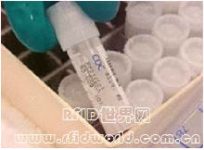
The world’s first case of cancer pathological sample RFID control
[ad_1]
The cell therapy equipment and tumor cell bank of Paoli Calmttes is one of the famous French medical laboratories and a well-known cancer research institution in Europe. These two units are applying the RFID system for pathological sample management, which is also the world’s first cancer pathological sample control application.
Automatic recognition of pathological samples
Before applying RFID technology, the Paoli Calmttes research institute needed to attach barcodes to test tubes and sampling bags (Figure 1). These pathological samples were stored in an extremely low temperature environment, such as a freezer and a liquid nitrogen tank.
The label is mainly connected to the back-end system to bring out pathological sample items, sampled patient data, related tests (such as histology, bacteriology, virology, etc.) and other key information. However, bar code labels stored in liquid nitrogen for a long time may disappear and be stained with moisture, which will result in a loss of reading rate; and the color code or ink mark on the bottle cap will also be difficult due to long storage time. Recognition; Moreover, in operation, it must be read individually for recognition, which is a time-consuming task for operators.

Figure 1. For the management of pathological samples, a barcode is attached to the outside of the bottle
Under such operations, the Paoli Calmttes Research Institute estimates that 5-10% of samples are lost each year, that is, the samples lost by these two units will be between US$3,000 and $5,000 per year. In order to achieve more accurate automatic identification, Paoli Calmttes research institute launched the introduction of RFID technology.
Realize point-to-point tracking
In fact, the transportation of all pathological samples must be regulated by international control regulations (see Figure 2). After the samples are frozen, they may deteriorate once they are exposed to room temperature or exposed to water and sunlight. Once the label is mislabeled or misidentified, some samples may be lost. In addition, pathological samples need to be destroyed after a certain period of time or the completion of the project. When the laboratory sample inventory is large and cannot be effectively identified, the destruction progress may be slowed down.

Figure 2. Five steps regulated by the regulations on the transportation of pathological samples
As a professional pathology laboratory, the sampling, transmission and storage of pathological samples at Paoli Calmttes Research Institute must of course comply with this set of international standards. After entering the processing room with professional masks, gloves, and surgical gowns, inspectors need to check the sample bottles and commission / Whether the information on the worksheet is consistent, determine the method and quantity of access according to the source and purpose of the pathological sample.
Under such a process, it and the solution manufacturer TAGSYS designed an RFID system. Now laboratory personnel can use a special RFID reader (as shown in Figure 3) to quickly read the RFID label on the sample and obtain information about the pathological sample. Speed up identification and verification, and help personnel to carry out the next step. And its special multi-reading function allows multiple glass bottles in an experimental sample tray to be successfully read and identified at the same time.
In addition, facing the extremely low temperature application environment in the processing room, the team used the RFID tag of the Small Disk Module to embed the corresponding sample-related data in the glass cover (Figure 3).
According to TAGSYS, the tag can withstand minus 320. The low temperature of F, and when the glass bottle is removed from the liquid nitrogen tank, it can withstand the rapid shaking to high temperature 257 within a few seconds. F

Figure 3. The RFID tag on the glass cover can be easily read by a handheld reader
Dr. Christian Chabannon, head of the Paoli Calmttes Research Institute, said: “Our introduction of RFID technology can be said to be a breakthrough in life sciences; compared with the past barcode applications, we can achieve automatic identification more efficiently.” “Through this RFID system application, we can safely and correctly perform seamless management of experimental samples, and eliminate our inefficiency or shortage of experimental data processing.” The solution manufacturer TAGSYS declared the RFID system (see Figure 4). ) Integrate a fixed desktop computer and a portable handheld reader, which can query 100 RFID tags within 3 seconds (Paoli Calmttes Research Institute’s experimental sample tray can hold up to 100 glass bottles).

Figure 4. TAGSYS claims that the RFID system integrates a fixed desktop computer and a portable handheld reader
Promote the quality of treatment development
After completing the accurate and safe identification test of pathological samples, the Paoli Calmttes research institute has installed RFID tags on more than 70,000 pathological samples glass tubes in the two units. For the application of the collocation laboratory bank, it has also increased the tag memory to 2 kilobytes, to multiply more relevant information, and add a new security serial number.
Immediately after the Paoli Calmttes research institution, La Timone Hospital, La Conception Hospital and North University Hospital also applied RFID technology to the monitoring of their pathological samples to improve the efficiency of accurately identifying specific samples. At least more than 200,000 pathological sample glass tubes in these four research institutions have been equipped with RFID labels. RFID technology is being valued and introduced by the medical community to promote the quality and timeliness of treatment development.
[ad_2]



